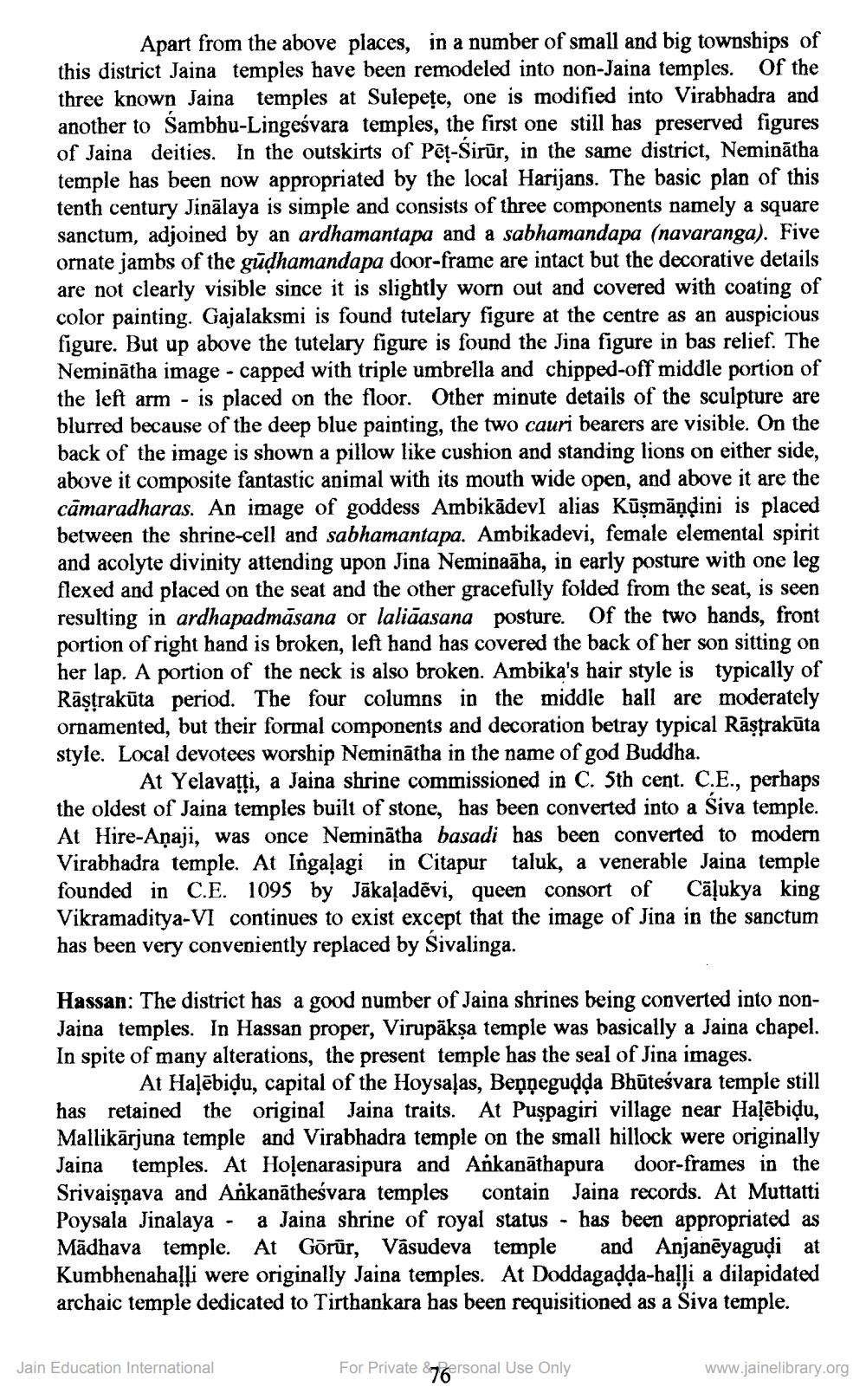________________
Apart from the above places, in a number of small and big townships of this district Jaina temples have been remodeled into non-Jaina temples. Of the three known Jaina temples at Sulepețe, one is modified into Virabhadra and another to Sambhu-Lingeśvara temples, the first one still has preserved figures of Jaina deities. In the outskirts of Pēt-Sirūr, in the same district, Neminātha temple has been now appropriated by the local Harijans. The basic plan of this tenth century Jinālaya is simple and consists of three components namely a square sanctum, adjoined by an ardhamantapa and a sabhamandapa (navaranga). Five ornate jambs of the gūdhamandapa door-frame are intact but the decorative details are not clearly visible since it is slightly worn out and covered with coating of color painting. Gajalaksmi is found tutelary figure at the centre as an auspicious figure. But up above the tutelary figure is found the Jina figure in bas relief. The Neminātha image - capped with triple umbrella and chipped-off middle portion of the left arm - is placed on the floor. Other minute details of the sculpture are blurred because of the deep blue painting, the two cauri bearers are visible. On the back of the image is shown a pillow like cushion and standing lions on either side, above it composite fantastic animal with its mouth wide open, and above it are the câmaradharas. An image of goddess Ambikādevl alias Kūşmāņdini is placed between the shrine-cell and sabhamantapa. Ambikadevi, female elemental spirit and acolyte divinity attending upon Jina Neminaāba, in early posture with one leg flexed and placed on the seat and the other gracefully folded from the seat, is seen resulting in ardhapadmāsana or laliāasana posture. Of the two hands, f portion of right hand is broken. left hand has covered the back of her son sitting on her lap. A portion of the neck is also broken. Ambika's hair style is typically of Rāstrakūta period. The four columns in the middle hall are moderately ornamented, but their formal components and decoration betray typical Rāstrakūta style. Local devotees worship Neminātha in the name of god Buddha.
At Yelavațti, a Jaina shrine commissioned in C. 5th cent. C.E., perhaps the oldest of Jaina temples built of stone, has been converted into a Siva temple. At Hire-Aņaji, was once Neminātha basadi has been converted to modern Virabhadra temple. At Ingaļagi in Citapur taluk, a venerable Jaina temple founded in C.E. 1095 by Jākaļadēvi, queen consort of Cāļukya king Vikramaditya-VI continues to exist except that the image of Jina in the sanctum has been very conveniently replaced by Sivalinga.
Hassan: The district has a good number of Jaina shrines being converted into nonJaina temples. In Hassan proper, Virupākṣa temple was basically a Jaina chapel. In spite of many alterations, the present temple has the seal of Jina images.
At Haļēbiļu, capital of the Hoysaļas, Beppegudda Bhūteśvara temple still has retained the original Jaina traits. At Puşpagiri village near Haļēbiļu, Mallikārjuna temple and Virabhadra temple on the small hillock were originally Jaina temples. At Hoļenarasipura and Ankanāthapura door-frames in the Srivaişņava and Ankanātheśvara temples contain Jaina records. At Muttatti Poysala Jinalaya - a Jaina shrine of royal status - has been appropriated as Mādhava temple. At Görür, Vāsudeva temple and Anjanēyaguļi at Kumbhenahaļļi were originally Jaina temples. At Doddagadda-halli a dilapidated archaic temple dedicated to Tirthankara has been requisitioned as a Siva temple.
Jain Education International
For Private 76ersonal Use Only
www.jainelibrary.org




